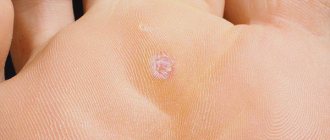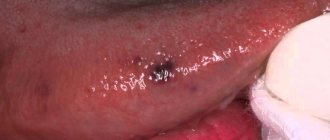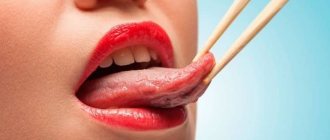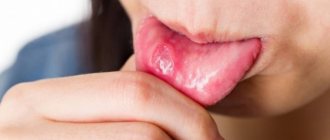Causes of warts in the mouth
Warts on the tongue are often also called papillomas of the oral cavity, since pathological growth of the epidermis of the mucous membrane occurs only if the patient is infected with the human papillomavirus (HPV), which can occur through contact or household means. The viral agent itself is so widespread that, according to various statistics, its carriers are from 80% to 90% of the entire population of the planet. However, for most people, the virus remains latent for a long time, without manifesting itself until the following conditions occur:
- Weakened immunity, immunodeficiency states;
- Microtraumas of the mucous membranes of the oral cavity, especially the epidermis lining the tongue;
- Oral sex with a carrier of the papilloma virus;
- Violation of the rules of hygienic oral care;
- Poor nutrition, vitamin deficiency;
- Stress and overwork.
Prevention
In order to avoid accidental infection, you must:
- Strict adherence to personal hygiene;
- Reducing stressful situations;
- Strengthening the immune system;
- Timely treatment of viral diseases;
- Maintaining a healthy lifestyle;
- Proper nutrition;
- Limit close contacts with an infected partner;
- Avoiding hypothermia;
- Complete rest, lasting at least 8 hours.
Localization and types of warts on the tongue
The most common location for benign tumors in the mouth is the front of the tongue. Especially often, atypical growth of epidermal cells of the mucous membrane is observed at the tip of the tongue and along its lateral parts. In rare cases, warts may cover the entire dorsal surface of the organ. Papillomas almost never form on the root of the tongue.
Warts on the tongue can be represented by one of two types of neoplasms:
- Flat warts. They are a bright pink or reddish papule that has a dense, hard consistency.
- Pointed warts (condylomas). Visually similar to pale epidermal papillae. As they grow, condylomas often merge, forming lobular growths that resemble cauliflower. Genital warts are most often localized under the tongue.
Treatment methods
Drug therapy is carried out at the initial stage of the formation of papillomas in the mouth. All other growths are removed surgically. Folk remedies will help strengthen the body's defenses, prevent the growth of formations and the development of complications.
Until complete removal of growths from the diet, you need to exclude hard, sour, spicy, salty, hot and cold foods.
Medicines
The choice of medications depends on the type of growth, the cause of its appearance, the general condition and age of the patient.
How to treat growths:
Antiviral ointments and tablets - Acyclovir, Panavir, Altabor. Prescribed for papillomas to suppress HPV activity.
Acyclovir
Panavir
Altabor
Solutions for injections – Ferrovir, Immunomax, Cycloferon. More effective against HPV than pills.
Ferrovir
Immunomax
Cycloferon
Rectal suppositories with antiviral and immunostimulating effects - Galavit, Kipferon, Genferon.
Galavit
Kipferon
Genferon
Immunomodulators – Likopid, Neovir.
Lycopid
Neovir
Local antiseptics – Chlorhexidine, Chlorophyllipt. Eliminate inflammation, bleeding, prevent the spread of infection.
Chlorophyllipt
Vitamin A oil solution – prevents tumor growth. Treat the growth daily.
Vitamin A
Vitamin complexes – Supradin, Complivit, Ascorutin.
Supradin
Complivit
Askorutin
If growths are detected during pregnancy, immunostimulating drugs - Viferon, Reaferon. Safe immunomodulators for children - Amiksin, Viferon.
Viferon Reaferon Amiksin
Folk remedies
Non-traditional methods will not help cope with growths on the tongue.
But folk remedies have anti-inflammatory, antiseptic effects and help strengthen the immune system. They can be used to enhance the therapeutic effect of drugs. When removing growths surgically, folk remedies are not used.
Recipes:
- Pour 500 ml of boiling water over 20 g of dry plantain leaves and leave in a sealed container for 15 minutes. Drink the strained infusion 100 ml twice a day. The duration of treatment is 10 days. The product increases the body's resistance to viruses.
- Grind the peeled pink potatoes and squeeze the juice through cheesecloth. Drink 100 ml before breakfast. Duration of treatment – 3 weeks. The drink has a pronounced immunostimulating effect.
- Pour 500 ml boiling water 1 tbsp. l. dry chamomile or calendula inflorescences, leave for an hour. Use the strained infusion to rinse your mouth twice a day for 10 days. This remedy is a natural antiseptic and accelerates the healing process of damaged tissue.
- Mix 4 parts hemp oil with 1 part honey. Treat the growths with the mixture 5 times a day.
- Lubricate the new growths 2-3 times a day with fresh juice of sour apples.
- Treat the growths with raw chicken protein. Apply every 15 minutes for an hour. Do the procedure three times a day. The duration of treatment is 10 days.
- Mix 100 g of chopped beets, 200 g of carrots. Add 1 lemon, twisted in a meat grinder along with the peel, 30 ml of olive oil, 100 g of walnuts. There are 1-2 tbsp. l. in a day. This vitamin complex strengthens the immune system.
Important! It is often recommended to use fresh celandine juice to treat growths on the tongue. This method is dangerous, the plant is poisonous, you can get poisoned. If the juice gets on healthy tissue, it will cause a severe burn. Papillomas in the mouth cannot be cauterized with hydrogen peroxide, vinegar, or removed with thread.
Removing growths
There are several methods for removing growths on the tongue. The choice depends on the location of the neoplasm and the presence of contraindications in the person.
Methods for removing growths:
| Surgically | Excision of the tumor with a scalpel under local anesthesia. The wound is disinfected, sutured, and the stitches are removed after a few days. The method is affordable, but causes a lot of discomfort during and after the operation. Contraindications: pregnancy and lactation, exacerbation of herpes, acute infectious and inflammatory processes in the body. |
| Laser | The most popular method of removing growths. The tumor is removed quickly and without pain - the procedure lasts no more than 20 minutes. There is no infection in the wounds, relapses are rarely diagnosed, and the rehabilitation process is short. Laser therapy can be used to remove tumors in children over 2 years of age. Contraindications – tumor size more than 3 cm, diabetes mellitus, pregnancy and breastfeeding, diseases of the circulatory system. Disadvantages: high cost, inability to send tumor tissue for histology. |
| Cryodestruction | Before the procedure, it is necessary to cure all infectious diseases. The affected area is exposed to liquid nitrogen, which stops the growth of the growth. During the session, the risk of infection and bleeding is reduced to zero. The duration of the procedure is 30 seconds. Cryodestruction is safe for children over 1 year of age. But this method is painful, often scars form at the site of exposure to cold, and it is difficult to control the depth of freezing. The method is not used to remove multiple tumors. After the session, immunity sharply decreases, so after removing the growth you should immediately start taking immunostimulating drugs. Contraindications – epilepsy, convulsions, arterial hypertension, vasospasm, pregnancy and lactation. Cryodestruction is not suitable for removing growths on the uvula and sublingual frenulum. |
| Electrocoagulation | A special loop is placed on the growth, which transmits electric current deep into the tissue. The tumor is cut off, and the vessels are sealed at the same time, which prevents bleeding. The method is painful, recovery takes a long time. But scars do not form, relapses are rare, and several tumors can be removed at once. After an incorrect procedure, scars may remain. |
| By radio waves | Non-invasive, bloodless procedure. After removing the growth, tissue samples can be sent for histology. The method is rarely used, since radio waves negatively affect healthy tissue, and relapses often occur. Contraindications: pregnancy and lactation, exacerbation of chronic pathologies, acute forms of infectious diseases, heart disease, diabetes mellitus. |
| Sclerosis | Used to remove vascular growths. The vessels are cauterized; when the blood supply is cut off, the growth stops growing and developing. |
| Galvanocaustics | A small growth is cauterized with platinum wire, preheated under the influence of current. The method is fast, without the risk of infection and bleeding. |
| Ultrasound | Ultrasonic waves of high intensity destroy damaged cells, but do not affect healthy tissue. The method is safe and effective, but has a high cost. |
Before any surgical intervention, a complete sanitation of the oral cavity is performed.
How to remove papilloma on the tongue using electrocoagulation:
How to get rid of growths?
Neoplasms on the tongue appear rarely. It does not matter the diet, the temperature of the food consumed or bad habits.
Let's look at methods for removing growths:
- Antibacterial agents help relieve inflammation and are used when rinsing and treating growths. Antiseptics and immunocorrectors are also used.
- The use of antibiotics to suppress and destroy the virus.
- Comprehensive measures involve the use of medications to overcome the effect of the virus after surgical removal. At the last stage, a vitamin complex is prescribed to restore the body’s protective functions.
The operation to remove tumors is simple. Surgeons excise the wart and cauterize the wound. Removal of tumors using radio waves is becoming increasingly popular due to its low incidence of injury, absence of pain, and harmlessness to children.
Drug therapy
Interferon
Treatment of papillomas should be comprehensive, which includes drug and surgical therapy. Before prescribing medications, the doctor cleans the oral cavity, eliminating white plaque and pockets through which infection can enter the body.
For this purpose, the oral cavity is sanitized, and then treated with ointment, which has an antiviral effect. This could be, for example, “Bonaftone”, “Adimal” or “Megosin” ointment. It is necessary to treat the oral cavity from below and from above.
Then the doctor prescribes antiviral and immunostimulating drugs, for example, Interferon or Panavir, and vitamin complexes. Their action is aimed at increasing the body's defenses. The doctor selects medications based on the individual characteristics of the body, taking into account contraindications and side effects.
ethnoscience
Treatment with folk remedies is possible only after consultation with your doctor. Typically, such treatment acts as an additional method, but it is not recommended to use it as an independent method of therapy, since complications such as oncology may develop.
Together with medications, the patient can use herbal infusions and decoctions to increase the body's defenses. Infusions can be prepared from rose hips, lemon balm, chamomile, plantain and other herbs.
You can drink 100 milliliters of red potato juice every day.
Celandine has a good effect. Its juice is applied to the affected areas if the growths are small. The procedure is repeated three times a day, the full course of treatment is about one month.
Which doctor should I contact?
To diagnose the disease, you must first consult a therapist. It is he who will examine the person and establish a presumptive diagnosis, after which he will issue a referral to an infectious disease specialist (this is a viral disease) and a dermatologist (although this is not skin, even the examination of a piece of tissue will be carried out using the same methods as the examination of the skin).
The dentist plays an important role in establishing the diagnosis - he is the first to notice neoplasms during a routine examination. Therefore, you should not neglect visits to him.









